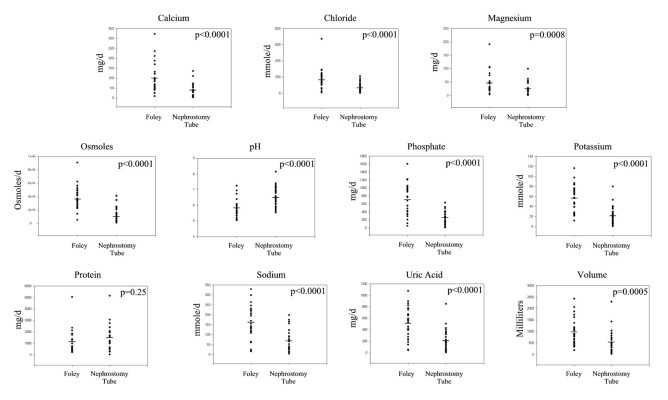Back to Journals » Research and Reports in Urology » Volume 1
Differences in quantitative urine composition in stone-forming versus unaffected mate kidneys
Authors Eisenberg M, Lee KL, Breyer BN, Walsh TJ, Konety BR, Stoller ML
Published 24 August 2009 Volume 2009:1 Pages 9—13
DOI https://doi.org/10.2147/RRU.S6580
Review by Single anonymous peer review
Peer reviewer comments 3

Michael L Eisenberg1, Keith L Lee1, Benjamin N Breyer1, Thomas J Walsh2, Badrinath R Konety1, Marshall L Stoller1
1Department of Urology, University of California San Francisco, San Francisco, CA, USA; 2Department of Urology, University of Washington, Seattle, WA, USA
Objectives: Many patients present with bilateral stones. There is a unique group of patients, however, that presents with stones exclusively on one side. We hypothesize that in such situations, 24-hour urine collections may not reveal specific defects on the affected stone-bearing kidney. We therefore evaluated selective 12-hour urine collections after percutaneous nephrolithotomy (PNL) to help determine if there is differential renal excretion.
Methods: We collected urine specimens from patients with nephrolithiasis who underwent unilateral PNL. Urine samples were collected and analyzed from nephrostomy tubes, representing the affected kidneys, and from Foley bladder catheters, representing the contralateral mate kidney.
Results: Thirty-one patients were studied (14 with unilateral nephrolithiasis and 17 with bilateral). Treated kidneys from patients with unilateral nephrolithiasis displayed lowered urine excretion of uric acid, sodium, chloride, calcium, and total osmoles when compared to patients with bilateral nephrolithiasis. Stone size and length of procedure were not predictive of urine composition after PNL.
Conclusions: Treated kidneys from patients with a history of unilateral stone disease revealed marked differences in urine excretion compared to those with bilateral nephrolithiasis after unilateral PNL. These findings could be secondary to the surgical insult, urinary stone disease, or could be a responsible factor for stone pathogenesis.
Keywords: percutaneous nephrolithotomy, kidney, stone, nephrolithiasis
 © 2009 The Author(s). This work is published and licensed by Dove Medical Press Limited. The full terms of this license are available at https://www.dovepress.com/terms.php and incorporate the Creative Commons Attribution - Non Commercial (unported, v3.0) License.
By accessing the work you hereby accept the Terms. Non-commercial uses of the work are permitted without any further permission from Dove Medical Press Limited, provided the work is properly attributed. For permission for commercial use of this work, please see paragraphs 4.2 and 5 of our Terms.
© 2009 The Author(s). This work is published and licensed by Dove Medical Press Limited. The full terms of this license are available at https://www.dovepress.com/terms.php and incorporate the Creative Commons Attribution - Non Commercial (unported, v3.0) License.
By accessing the work you hereby accept the Terms. Non-commercial uses of the work are permitted without any further permission from Dove Medical Press Limited, provided the work is properly attributed. For permission for commercial use of this work, please see paragraphs 4.2 and 5 of our Terms.
